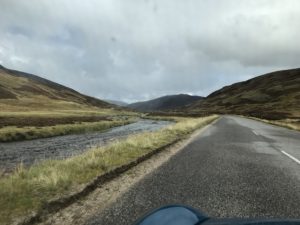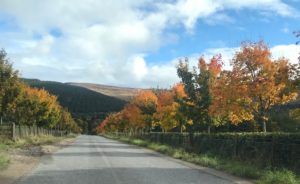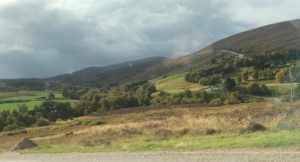In which Sid and Doris go past Glamis, Braemar and Balmoral castles to drive the wild Cairngorm road to the capital of The Highlands.
 Dundee was changed a lot. Tenements that never had a WC or bathroom were torn down, and a lot more besides because the demolition firms paid off the Labour councillors to vote for extra destruction. A lot of Victorian buildings that would now be Heritage were taken down. Still people could have a bath at home, which is important. In 2015 Gerry Hassan wrote a great article on the role of the Scottish Labour Party called Can Scottish Labour clear up the mess it has got itself into? And given the collapse of the Labour vote in recent elections the answer would seem to be No.
Dundee was changed a lot. Tenements that never had a WC or bathroom were torn down, and a lot more besides because the demolition firms paid off the Labour councillors to vote for extra destruction. A lot of Victorian buildings that would now be Heritage were taken down. Still people could have a bath at home, which is important. In 2015 Gerry Hassan wrote a great article on the role of the Scottish Labour Party called Can Scottish Labour clear up the mess it has got itself into? And given the collapse of the Labour vote in recent elections the answer would seem to be No. Anyway, back at the McManus we go first to the part which is History of the City. The museum building was purpose built by George Gilbert Scott in full Gothic style. Unfortunately it was built on a bog and in time the timbers it was built on rotted requiring a major refit onto concrete rafts in 2005, retaining the Gothic Revival heritage. This is a very good museum with plenty of past to work with. There is a whole exhibition on the two Tay bridges. And did you know Michelin made original equipment tyres in Dundee? Had you forgotten that D.C. Thomson published not only the Courier, Beano and Dandy but also Bunty for girls? Bothy McW hastens off to amend his entry.
Anyway, back at the McManus we go first to the part which is History of the City. The museum building was purpose built by George Gilbert Scott in full Gothic style. Unfortunately it was built on a bog and in time the timbers it was built on rotted requiring a major refit onto concrete rafts in 2005, retaining the Gothic Revival heritage. This is a very good museum with plenty of past to work with. There is a whole exhibition on the two Tay bridges. And did you know Michelin made original equipment tyres in Dundee? Had you forgotten that D.C. Thomson published not only the Courier, Beano and Dandy but also Bunty for girls? Bothy McW hastens off to amend his entry.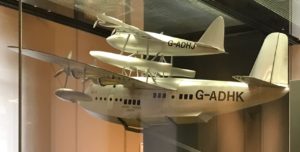 How about the idea of launching one seaplane by taking it up on the back of an Empire flying boat because the first plane is too full of fuel to get off on its own? Is that how NASA launched the space shuttles, oh yes.
How about the idea of launching one seaplane by taking it up on the back of an Empire flying boat because the first plane is too full of fuel to get off on its own? Is that how NASA launched the space shuttles, oh yes.
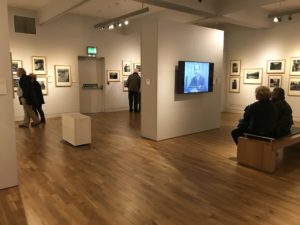 And so back to the photography. We would never have heard of Joseph McKenzie if our neighbour were not his son. These are excellent mostly black and white photos, beautifully developed, that record the city and the people. As he never took any notes, letting the pictures speak for themselves, the curators have done very well to find context using out takes from local oral histories. They ask anyone who recognises people or scenes to contact the curators. Pictures may be better than thousands of words, but the combination is even better. The museum is largely deserted but the McKenzie exhibition is full of couples of a certain age.
And so back to the photography. We would never have heard of Joseph McKenzie if our neighbour were not his son. These are excellent mostly black and white photos, beautifully developed, that record the city and the people. As he never took any notes, letting the pictures speak for themselves, the curators have done very well to find context using out takes from local oral histories. They ask anyone who recognises people or scenes to contact the curators. Pictures may be better than thousands of words, but the combination is even better. The museum is largely deserted but the McKenzie exhibition is full of couples of a certain age.
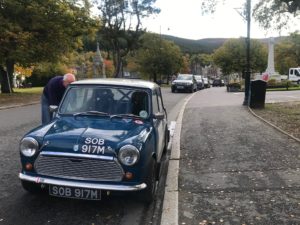 Sid gets a turn and we drive into Ballater where we hope to have lunch in the old railway station where Queen Victoria had her own waiting room, handy for Balmoral. We find it shut, the only other jolly cafe has a short queue and is fronted by a person who takes about four minutes to make a coffee. If you are used to city speeds this is about enough to cause your arteries to burst as the blood pressure goes off the dial and Doris walks away. A nearby pub sells coffee.
Sid gets a turn and we drive into Ballater where we hope to have lunch in the old railway station where Queen Victoria had her own waiting room, handy for Balmoral. We find it shut, the only other jolly cafe has a short queue and is fronted by a person who takes about four minutes to make a coffee. If you are used to city speeds this is about enough to cause your arteries to burst as the blood pressure goes off the dial and Doris walks away. A nearby pub sells coffee.
We drive away through the autumn colours past Glen Gairn (nice single track humped bridge), Corgarff, Ballindalloch and Tomintoul. You needn’t look them up on the map, just say them out loud to yourself. 20% hills and over the Sloch summit which boasts 405m – Hermann Zer German laughs quietly from his nice warm dry garage back in Bishop’s Stortford.
 There are only a few ways through the Cairngorms and so our road is sharing its pass with the main Edinburgh-Inverness railway line. Doris navs a wily detour so we can see the underside of Murdoch Paterson’s Findhorn Highland Railway steel latticed viaduct. Sid found the details on www.Victorianweb.org which will repay further perusal (as a Victorian might say).
There are only a few ways through the Cairngorms and so our road is sharing its pass with the main Edinburgh-Inverness railway line. Doris navs a wily detour so we can see the underside of Murdoch Paterson’s Findhorn Highland Railway steel latticed viaduct. Sid found the details on www.Victorianweb.org which will repay further perusal (as a Victorian might say).
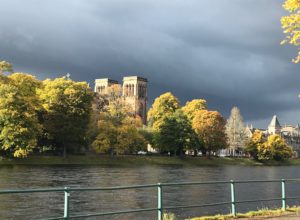 Blog central is in a fine hotel room with a view over the Ness towards the cathedral. The picture shows the towers outlined against the storm clouds. It is, or has recently been, raining.
Blog central is in a fine hotel room with a view over the Ness towards the cathedral. The picture shows the towers outlined against the storm clouds. It is, or has recently been, raining.

